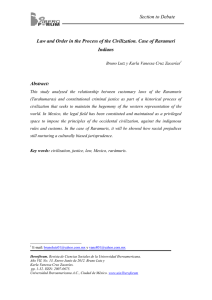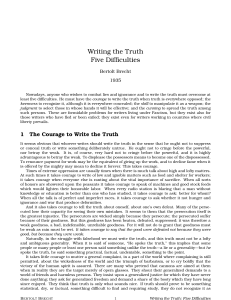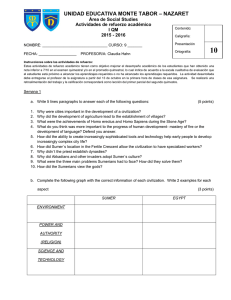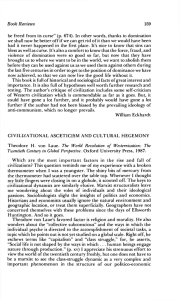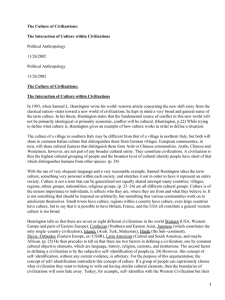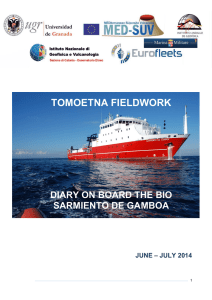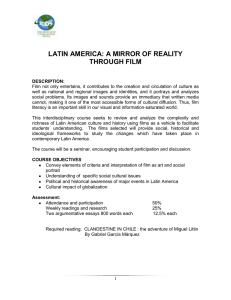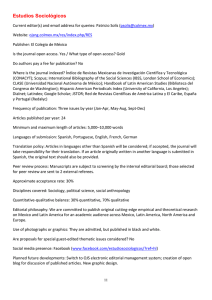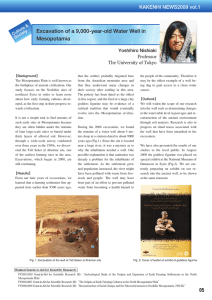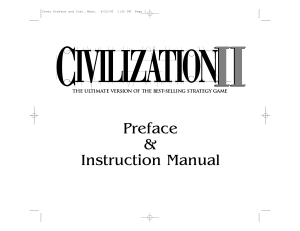Civilization and Barbarism
Anuncio
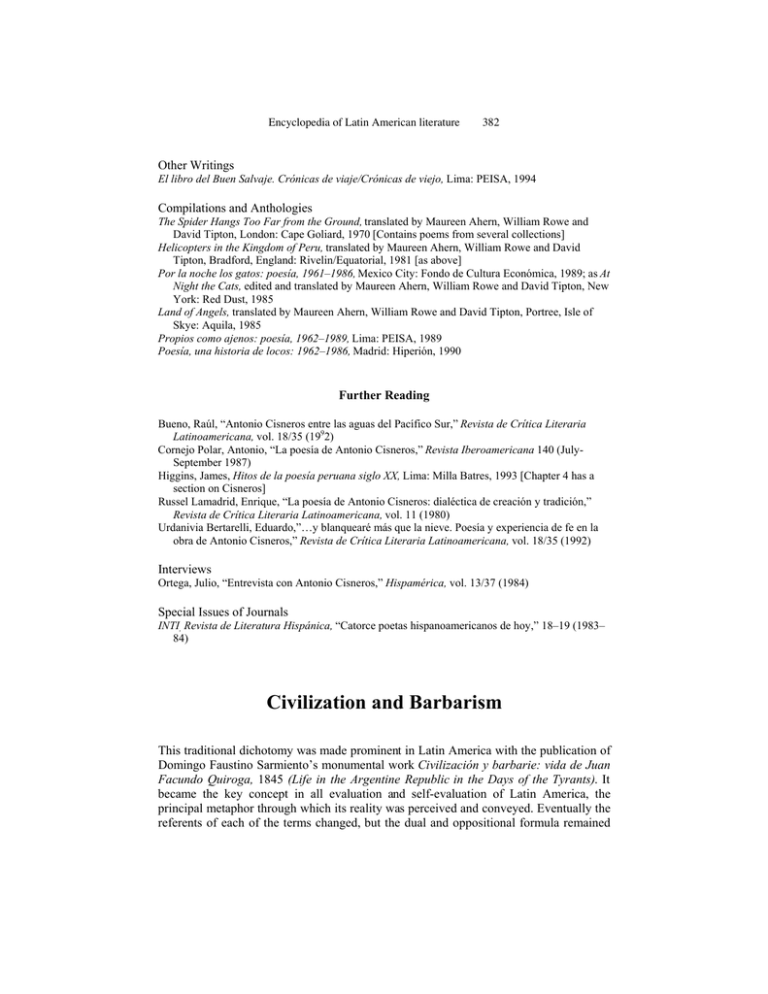
Encyclopedia of Latin American literature 382 Other Writings El libro del Buen Salvaje. Crónicas de viaje/Crónicas de viejo, Lima: PEISA, 1994 Compilations and Anthologies The Spider Hangs Too Far from the Ground, translated by Maureen Ahern, William Rowe and David Tipton, London: Cape Goliard, 1970 [Contains poems from several collections] Helicopters in the Kingdom of Peru, translated by Maureen Ahern, William Rowe and David Tipton, Bradford, England: Rivelin/Equatorial, 1981 [as above] Por la noche los gatos: poesía, 1961–1986, Mexico City: Fondo de Cultura Económica, 1989; as At Night the Cats, edited and translated by Maureen Ahern, William Rowe and David Tipton, New York: Red Dust, 1985 Land of Angels, translated by Maureen Ahern, William Rowe and David Tipton, Portree, Isle of Skye: Aquila, 1985 Propios como ajenos: poesía, 1962–1989, Lima: PEISA, 1989 Poesía, una historia de locos: 1962–1986, Madrid: Hiperión, 1990 Further Reading Bueno, Raúl, “Antonio Cisneros entre las aguas del Pacífico Sur,” Revista de Crítica Literaria Latinoamericana, vol. 18/35 (1992) Cornejo Polar, Antonio, “La poesía de Antonio Cisneros,” Revista Iberoamericana 140 (JulySeptember 1987) Higgins, James, Hitos de la poesía peruana siglo XX, Lima: Milla Batres, 1993 [Chapter 4 has a section on Cisneros] Russel Lamadrid, Enrique, “La poesía de Antonio Cisneros: dialéctica de creación y tradición,” Revista de Crítica Literaria Latinoamericana, vol. 11 (1980) Urdanivia Bertarelli, Eduardo,”…y blanquearé más que la nieve. Poesía y experiencia de fe en la obra de Antonio Cisneros,” Revista de Crítica Literaria Latinoamericana, vol. 18/35 (1992) Interviews Ortega, Julio, “Entrevista con Antonio Cisneros,” Hispamérica, vol. 13/37 (1984) Special Issues of Journals INTI, Revista de Literatura Hispánica, “Catorce poetas hispanoamericanos de hoy,” 18–19 (1983– 84) Civilization and Barbarism This traditional dichotomy was made prominent in Latin America with the publication of Domingo Faustino Sarmiento’s monumental work Civilización y barbarie: vida de Juan Facundo Quiroga, 1845 (Life in the Argentine Republic in the Days of the Tyrants). It became the key concept in all evaluation and self-evaluation of Latin America, the principal metaphor through which its reality was perceived and conveyed. Eventually the referents of each of the terms changed, but the dual and oppositional formula remained A-Z 383 constant. The origins of the terms are interesting to note: civilization harks back to its Greek meaning of city whereas barbarism, also Greek in origin, was simply the way the Greeks referred to those whose language was not Greek and pronounced Greek badly. By the time these terms came to be used by Sarmiento they had become clearly hierarchical: the worst and the best stages in the evolution of nations. But Sarmiento simply highlighted and adapted a trope that had prevailed in connection with America from the time of the conquest, and even before, when the constricted imagination of medieval Europe had felt the need for an idealised Other against which to measure itself. This took the form of both an Utopia that would serve to show up Europe’s own imperfections, and its opposite, a place of savagery which would allow it to exult in its own superiority. Recent studies of the first writings about the newly discovered continent reveal a carefully constructed text to reflect this dual position. For instance, in his letters, Columbus simultaneously enthuses over the beauty, docility and good-nature of the natives he has come upon (as if to fulfill expectations of having reached the Indies), whilst at the same time warning against the natives’ lack of disciplined behaviour and barbaric cannibalistic practices (in justification of conquest and colonization). But under colonialism, it is almost exclusively the latter image of barbarism that is made to predominate, the indigenous population demonized and their cultures ignored or erased. At best, the attitude was of America as a tabula rasa awaiting the imprint of civilization. Only some lone voices, such as Bartolomé de Las Casas pointed out that barbarism was a subjective criterion, dependant upon the speaker’s position. Antoniello Gerbi, in his La disputa del Nuevo Mundo, 1960 [The Dispute of the New World] traces the continuously Eurocentric debate concerning the New World, highlighting the uninterrupted flow of theories on the inferiority of America, from Buffon’s assertion that America is a more recent and still immature continent where animals fail to reach their full growth potential, to Cornelius De Pauw’s view that things degenerate in America’s unhealthy climate and Hegel’s unflinching acceptance of these ideas. These became foundational beliefs, later developed by theories of environmental and biological determinism which, together with the racial pyramid of Positivist thought, were the philosophical ideas that exerted the greatest influence in the political thought of post-independence American states. From Mexico to Argentina, the dynamics of history were seen as a conflict between native barbarism and cosmopolitan civilization. Sarmiento, in Facundo, declared that these key terms were transitional, adding that since barbarism was the earlier one, it would be eradicated by the inevitable forward march of progress. The conditions most conducive to barbarism were those of life on the pampas, where the extension of the territory and its rigours made human communication difficult if not impossible, and allowed for the rule of brute force by the local petty tyrants, the caudillos. It was a primitive, retrograde way of life which had become a stumbling block in the development of the nation. Hispanic colonial rule, with its insistence on traditional, conservative values and blind authoritarianism, had done little to alter this basic picture but was now seen to provide a stepping stone to a more progressive system, a civilization based upon the European model. Sarmiento’s ideal civilization was that of the industrialized AngloSaxon countries of northern Europe, their chief virtues being their democratically elected government and their liberal laissez-faire policies. Reason, order, system, strategy are some of the key words that describe civilization; another is cosmopolitanism with a Encyclopedia of Latin American literature 384 decidedly European bent. Literary critics have often pointed out that Facundo’s narrative style does not support the clear-cut division of the political message arguing that the romantic exuberance of Sarmiento’s prose betrayed an ambivalence in his position. There is much truth in this concerning the artist’s aesthetic sensibility, but little as regards the politician. Sarmiento’s ruthless political programme was, at the time of writing Facundo, unequivocal: he advocated massive immigration, preferably from the industrialised countries of northern Europe in order to “whiten the desert” and bring Argentina nearer to the coveted way of life which he termed “civilization.” The first step to achieve this was to be the wholesale extermination of the gauchos and their way of life, or, at best, their absorption into the new order. (He was to reverse his ideas once his desired policies were put into execution.) José Hernández, in his epic poem in two parts, Martin Fierro (1872 and 1879), depicts this extermination, but in his version barbarism is imposed upon the gaucho by the policies of a centralized government whose methods are corruption, treachery and forcible conscription. Barbarism is also depicted as the natural condition of the Indians who have become the new cultural underdogs. The most famous fictionalised attempt to dramatise the conflict between the dual forces of civilization and barbarism is found in Doña Bárbara (1928) by Rómulo Gallegos. In this novel, nature, represented in its unbridled barbarism by the eponymous heroine, is defeated by the forces of enlightenment and the promise of a new dawn (her rival and victor is called Santos Luzardo, luz being the Spanish for “light”). Sarmiento’s ideas, though continuing to be influential throughout the sub-continent, were beginning to be questioned in the face of events once they had become implemented. The Cuban José Martí, at first an admirer of Sarmiento, moved the debate surrounding civilization and barbarism on to a moral plane. Taking the US as an example of a nation that followed the path of “civilization,” he suggested that whilst the economic and political advances of industrialising countries such as the US were undisputed, Latin America had other, more valuable spiritual assets which it ought not to betray. Arguing against the crude importation of ideas from Europe and the US, Martí wrote in his essay “Nuestra America” (Our America) of 1891: “No hay batalla entre la civilización y la barbarie, sino entre la falsa erudición y la naturaleza.” (It is not a question of a battle between civilization and barbarism, but between false learning and Nature). These sentiments were echoed by the Uruguayan José Enrique Rodó, whose essay Ariel inspired a new generation with a measure of pride in their Latin American cultural heritage. In the first decades of the 20th century, when the advantages of this new American promise had already begun to disappoint, the debate evolved around the problems attendant upon the encroachment of Modernism. A new aesthetic flourished in the literary movement called criollismo (creolism), which spread across the sub-continent this time aligning wisdom with a mythical past golden age in which those who had previously been held to be barbarians became the new repositories of civilization. In Ricardo Güiraldes’s Bildungsroman Don Segundo Sombra (1926), a complete volte face has taken place, with the eponymous gaucho becoming the highest exponent of civilization. As a result of the vertiginous growth of the city, the rural countryside has once again become the seat of “true” civilization, and gaucho life is presented as one of seamless physical and spiritual harmony. Sylvia Molloy, in her study of autobiography, At Face Value (1991), draws parallels between Sarmiento and the Mexican José Vasconcelos. For the latter, barbarism equalled A-Z 385 ignorance which he and his party as self-appointed educators of the nation sought to eradicate. The polarized forces of nativism or indigenismo and universalism became the conflicting forces in a search for national identity. In recent years, feminists have adapted Sarmiento’s worn terminology to the situation of women in Latin America. The most important study on these lines is Francine Masiello’s Between Civilization and Barbarism: Women, Nation and Literary Culture in Modern Argentina (1992), an exploration of the positioning of women in the changing cultural constructions of the nation. Masiello’s revisionist reading suggests the “collapse of these false dichotomies.” The construction of women, either as the civilizing influence of the homemaker and thus supporter of the patriarchal state, or as feared exponent of barbarism, irrational and anarchic creatures threatening the nation’s stability finds little support in the extensive documentation of women’s writing of the last hundred years. These reveal, instead a more fluid cultural history in which the distinctions of the official binary account are constantly blurred. The opposition between civilization and barbarism reappears in Borges’s “Poema conjetural” [Conjectural Poem] as stages in the discovery and acceptance of one’s inner destiny. In Out of Context (1993), Daniel Balderston expands upon this idea in his penetrating reading of Borges’s story “Historia del guerrero y de la cautiva” (Story of the Warrior and the Captive) in which he examines the strongly contested connotations of civilization and barbarism and its wide historical context. Even when emptied of its traditional values, the dualism of the trope continues to attract writers and critics as a powerful metaphor to express the contradictions of Latin America. EVELYN FISHBURN See also entries on Doña Bárbara (Rómulo Gallegos), Don Segundo Sombra (Ricardo Güiraldes) Further Reading Alonso, Carlos J., The Spanish American Regional Novel, Cambridge: Cambridge University Press, 1989 Brushwood, John S., Genteel Barbarism: Experiments in the Analysis of Nineteenth Century Spanish-American Novels, Lincoln: University of Nebraska Press, 1981 Fernández Retamar, Roberto, “Algunos usos de civilización y barbarie,” in his Para el perfil definitivo del hombre, Havana: Letras Cubanas, 1981; as Caliban and Other Essays, translated by Edward Baker, Minneapolis: University of Minnesota Press, 1989 Fitz, Earl E., Rediscovering the New World: Inter-American Literature in a Comparative Context, Iowa City: University of Iowa Press, 1991 González Echevarría, Roberto, The Voice of the Masters: Writing and Authority in Modern Spanish American Literature, Austin: University of Texas Press, 1985 Greenblatt, Stephen, Marvelous Possessions: the Wonder of the New World, Oxford: Oxford University Press, and Chicago: University of Chicago Press, 1991 Lojo de Beuter, María Rosa, La “barbarie” en la narrativa argentina (siglo XIX), Buenos Aires: Corregidor, 1994 Martínez, Tomás Eloy, “A Culture of Barbarism,” in Argentina in the Crisis Years (1983–1990): from Alfonsín to Menem, edited by Colin M.Lewis and Nissa Torrents, London: Institute of Latin American Studies, 1993
